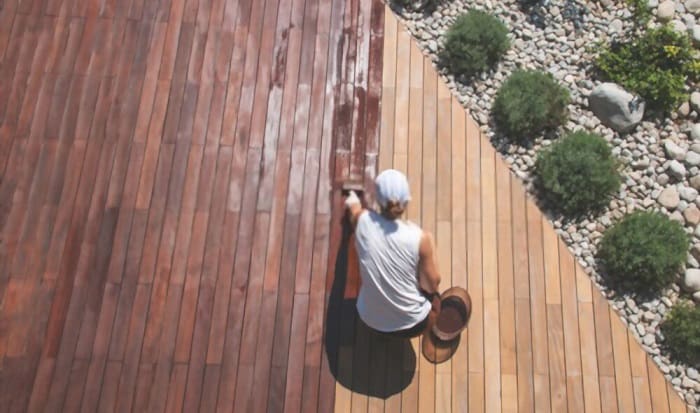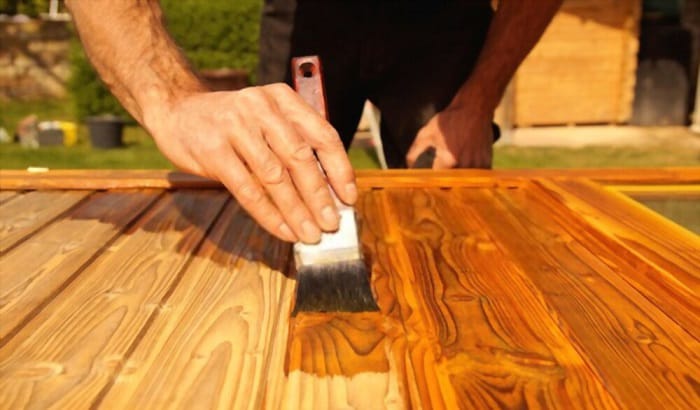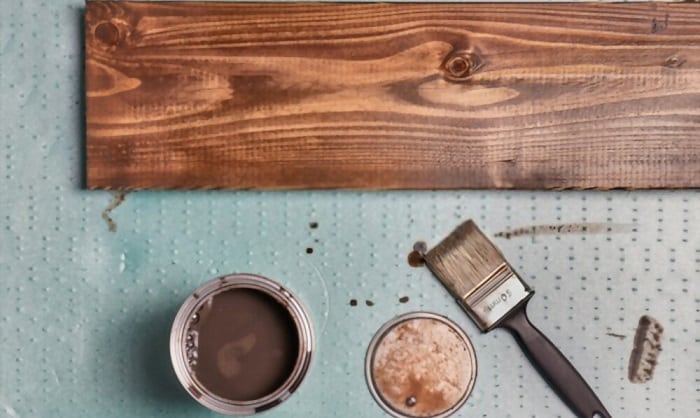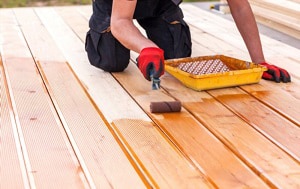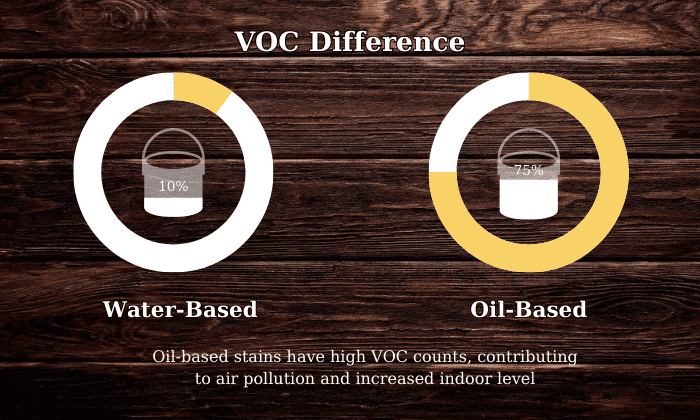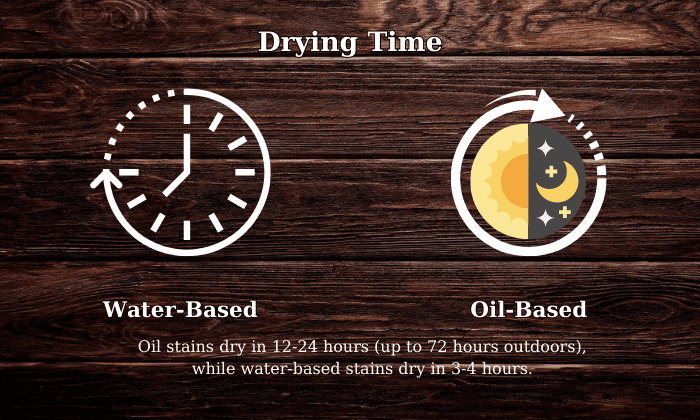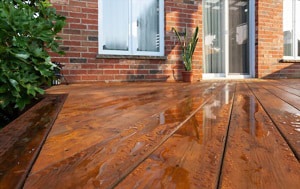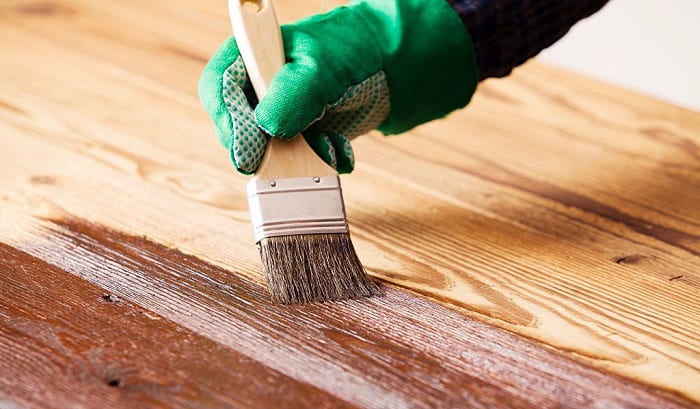Staining is one of the most popular types of wood finish techniques to protect its surface and improve its appearance. And among these finishes, most people will go for either oil or water based stain.
This begs the question—what’s the difference between oil based stain vs water based stain? Should you pick solely based on how appealing the stain looks, or are there other factors to take into consideration?
Read on to find out which kind of wood stain is best for your home.
Table of Contents
What Are They
1. Oil-based stain
The three common components of this traditional stain are linseed oil, petroleum distillates, and varnish. While oil-based stain’s initial strong smell can put some people off, it’s still widely favored due to its penetrative quality – a result of its thin density.
Oil-based stains’ color choices are rather limited. However, you can rest assured that their array of wood tones—available in both semi-transparent and transparent forms—is still nothing to scoff at.
2. Water-based stain
Available in opaque and semi-transparent formulas, water-based stains come in many colors thanks to the utilization of water-based dyes. And as they opt for water as a thinning agent rather than linseed oil, they are less flammable.
Unfortunately, with thickness taken into consideration, one can’t help but wonder how well water-based stains can penetrate the wood, if at all.
Differences
There’s no definitive answer as to which one is better: water based wood stain vs oil based. It all boils down to your preferences and what surface you’ll be staining. For example, the best option for dining table, for cabinets, or deck stain can differ drastically.
1. Durability
In this regard, the crown belongs to oil-based stains as they can penetrate far deeper into the wood thanks to their thinner consistency. On the other hand, water-based stains typically can’t seep into the wooden surface, so they peel easily.
Even if applied correctly, water-based finishes can show signs of blistering within the first year or so. The bad news is — recoating will not be possible without sanding away the flaky layer first, which can be time-consuming.
In contrast, oil-based varieties can’t peel. Instead, long exposure to the sun can make them fade. Once this happens, a quick touch-up will solve the problem. Alternatively, avoid oil-based stains for exterior use.
- If durability is your top priority, you might want to avoid semi-transparent oil-based stains. While it’s not always the case, these oil-based formulas may have high viscosity that can tamper with their penetrative qualities.
2. Wood grain effects
Oil-based stains don’t raise wood grains; this is why they are so common for those who want to keep the mineral streaks intact. In fact, these stains can enrich wood grains’ beauty, making them a good choice for furniture and hardwood floors.
On the contrary, water-based stains will raise the grains’ natural fibers due to the latter’s hygroscopic nature. The only way to avoid this effect is by reserving water stains for pine, white oak, and other water-resistant wood.
In most cases, a water-based stain application means you’ll have to pre-raise the wood grains first. This involves scrubbing the grains with 220-grit sandpaper and then lightly coating the surface with water.
- Flexibility
As water-based stains can contain dyes, their colors may range from traditional wood shades to more unconventional ones such as blue, red, and even custom colors.
In stark contrast, oil-based varieties mainly involve wood tones, so it can be harder to find a shade for kitchen cabinets that match your color scheme.
Fixing a mistake is noticeably easier for water-based finishes as well – a few simple wipes with diluted soap will suffice. As for oil-based stains, you need to have a solvent at hand in case you’re not satisfied with how the wood surface looks.
With that being said, applying water-based stains is still a challenging job. Over-application can spell disaster as they’ll peel more easily.
- Eco-friendliness
One glaring drawback of oil-based stains are their high volatile organic compound (VOC) counts. These are one of the culprits behind air pollution, and stains can raise indoor VOC concentration levels several times higher than the recommended standards.
Another reason oil formulas might not be the best contender for eco-friendliness is their flammability – a problem not present in their water-based counterparts.
Water-based stains, however, can still have a negative impact on the environment if they use non-renewable pigments. Plus, they usually require more frequent recoating, which can offset their initial advantage.
- UV light
Generally, water-based stains fare better against UV lights, making them an ideal choice for exterior use. For example, it’s better to apply water-based stain on deck or for cedar fence outdoors, as they’re far less likely to fade.
On the other end of the spectrum are oil-based stains, which discolor quickly under the sun. Hence, they’re better for stairs, furniture, and hardwood floor indoors. If used under cover, oil stains can look new for very long (1 year at least), as pointed out by users on Reddit.
- Mold
Again, water-based stains are the winner here because they don’t block the surface’s pores. And as it’s less likely for water-based stains to trap moisture underneath, they’re less likely to promote mold development.
Unfortunately, oil-based stains’ highly-favored penetrative quality has become their downfall in this case. With how they can “seal” the wood surface, these finishes can pose the risk of moisture buildup and mold growth, especially in loose-grained wood such as teak.
- Dry time
While oil stains might “seem” dry to the touch within the first 2 hours, it actually takes these finishes 12-24 hours to completely dry. For outdoor applications, the waiting time can extend to a whopping 72 hours.
Excluding the curing time, water-based stains only require a short 3-4 hours. However, the long drying time of oil-based options can actually play out in your favor – it gives you an opportunity to apply the stain more evenly for an overall better-looking surface.
- Finish type
Compared to oil-based formulas, water-based options have a transparent and satin-like sheen to them. In addition, their color will not change whatsoever over time, meaning that they will stay clear for the rest of their life.
Oil stains, on the other hand, can be easily recognized with their matte finish and warm amber tone, which gradually grow to a deeper shade. This allows them to bring out the best in wood grains.
- Scratch resistance
Both oil-based and water-based stains offer your floor a degree of protection from scratches. Out of the two, oil-based formulas tend to fare better against this sort of damage, and once they scratch, the imperfections don’t show readily.
Nonetheless, oil-based stains are vulnerable to strong impact, so dropping something heavy will surely deface them.
- Water resistance
Oil-based stains shine again in this department with their penetrative qualities. Because they effectively seal off the wood’s pores, they can even protect the surface from rain. Water-based types, however, won’t offer such benefits.
- Cost
Even without re-applications taken into the equation, water-based stains will cost much more than oil-based ones. The disparity is so wide that the former’s price can be three times as much as the latter.
Pros and cons
1. Oil-based Stains
- Very durable, does not peel or flake
- Much easier to apply
- Provide an even finish
- Do not require you to pre-raise the wood grains
- Strong resistance to scratch damages
- Excellent water resistance
- More economical
- More flammable and produce strong odors
- Longer drying time
- Higher levels of VOCs – not friendly to the environment
- Might trap moisture, which can lead to internal decay
2. Water-based Stains
- Available in a wider range of colors
- Non-flammable
- Lower levels of VOCs
- Allow the wood to “breathe” to prevent moisture and mold
- Strong resistance to dent damage
- Do not fade under UV lights
- Peel and flake easily, requiring more frequent maintenance
- More difficult and problematic to apply
- Much higher cost
FAQs
How can you tell if a stain is oil or water-based?
If the label is still intact, you can simply look at the can to see whether the manufacturer classifies the stain as water- or oil-based. The label may also specify what solvent is necessary: water and soap for water-based and mineral spirits for oil-based types.
Alternatively, you can spray a bit of water onto the stain to see whether the droplets form beads – a sure indication of an oiled-based mixture.
Does an oil-based stain last longer than a water-based stain?
Yes. Because oil-based stains seep deep into the wood as opposed to sitting on top of it, they can last longer than most water-based stains. The only exception is when you expose oil-based formulas to UV lights, which water-based types have better tolerance against.
Why use an oil-based stain?
Oil-based stains are usually favored due to these three main reasons:
- Better durability
- Drastically lower cost
- Easy to apply more evenly
Can I use an oil-based stain over a water-based one?
You can, provided that you leave the water-based stain to dry for at least 24 hours. If you’re not sure whether the finish is dry yet, feel it with your hand – a cold sensation means it’s still not ready.
However, for best results, it’s best to remove all previous stains layers.
Conclusion
At this point, I’m sure you already have your answer as to which one is better—oil based stain vs water based stains.
If you’re still on the fence, think about what you prefer. For a more economical and durable option with excellent scratch resistance, go oil-based. If you can splurge a bit for a UV-resistant and eco-friendly stain, water-based is the best choice.
Have fun staining your wood surface.

Hi, I am Roseanne Jones, an aspiring home designer that wants to make you feel more at home with your new house.With nearly five years of redecorating old residents and arranging new ones, I am confident that I can give you the best advice on your lovely place.


